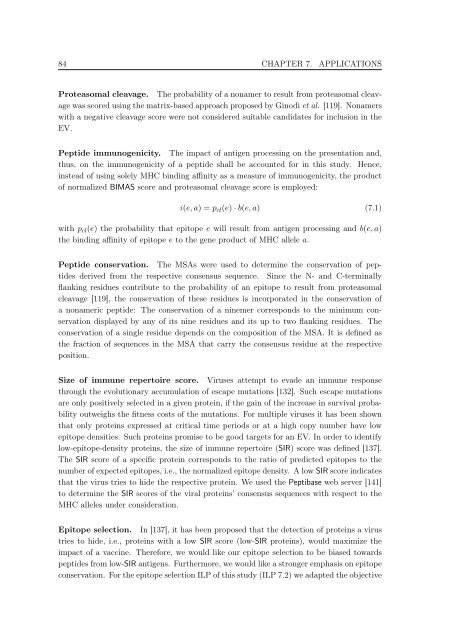New Approaches to in silico Design of Epitope-Based Vaccines
New Approaches to in silico Design of Epitope-Based Vaccines
New Approaches to in silico Design of Epitope-Based Vaccines
You also want an ePaper? Increase the reach of your titles
YUMPU automatically turns print PDFs into web optimized ePapers that Google loves.
84 CHAPTER 7. APPLICATIONS<br />
Proteasomal cleavage. The probability <strong>of</strong> a nonamer <strong>to</strong> result from proteasomal cleavage<br />
was scored us<strong>in</strong>g the matrix-based approach proposed by G<strong>in</strong>odi et al. [119]. Nonamers<br />
with a negative cleavage score were not considered suitable candidates for <strong>in</strong>clusion <strong>in</strong> the<br />
EV.<br />
Peptide immunogenicity. The impact <strong>of</strong> antigen process<strong>in</strong>g on the presentation and,<br />
thus, on the immunogenicity <strong>of</strong> a peptide shall be accounted for <strong>in</strong> this study. Hence,<br />
<strong>in</strong>stead <strong>of</strong> us<strong>in</strong>g solely MHC b<strong>in</strong>d<strong>in</strong>g aff<strong>in</strong>ity as a measure <strong>of</strong> immunogenicity, the product<br />
<strong>of</strong> normalized BIMAS score and proteasomal cleavage score is employed:<br />
i(e, a) = pcl(e) · b(e, a) (7.1)<br />
with pcl(e) the probability that epi<strong>to</strong>pe e will result from antigen process<strong>in</strong>g and b(e, a)<br />
the b<strong>in</strong>d<strong>in</strong>g aff<strong>in</strong>ity <strong>of</strong> epi<strong>to</strong>pe e <strong>to</strong> the gene product <strong>of</strong> MHC allele a.<br />
Peptide conservation. The MSAs were used <strong>to</strong> determ<strong>in</strong>e the conservation <strong>of</strong> peptides<br />
derived from the respective consensus sequence. S<strong>in</strong>ce the N- and C-term<strong>in</strong>ally<br />
flank<strong>in</strong>g residues contribute <strong>to</strong> the probability <strong>of</strong> an epi<strong>to</strong>pe <strong>to</strong> result from proteasomal<br />
cleavage [119], the conservation <strong>of</strong> these residues is <strong>in</strong>corporated <strong>in</strong> the conservation <strong>of</strong><br />
a nonameric peptide: The conservation <strong>of</strong> a n<strong>in</strong>emer corresponds <strong>to</strong> the m<strong>in</strong>imum conservation<br />
displayed by any <strong>of</strong> its n<strong>in</strong>e residues and its up <strong>to</strong> two flank<strong>in</strong>g residues. The<br />
conservation <strong>of</strong> a s<strong>in</strong>gle residue depends on the composition <strong>of</strong> the MSA. It is def<strong>in</strong>ed as<br />
the fraction <strong>of</strong> sequences <strong>in</strong> the MSA that carry the consensus residue at the respective<br />
position.<br />
Size <strong>of</strong> immune reper<strong>to</strong>ire score. Viruses attempt <strong>to</strong> evade an immune response<br />
through the evolutionary accumulation <strong>of</strong> escape mutations [132]. Such escape mutations<br />
are only positively selected <strong>in</strong> a given prote<strong>in</strong>, if the ga<strong>in</strong> <strong>of</strong> the <strong>in</strong>crease <strong>in</strong> survival probability<br />
outweighs the fitness costs <strong>of</strong> the mutations. For multiple viruses it has been shown<br />
that only prote<strong>in</strong>s expressed at critical time periods or at a high copy number have low<br />
epi<strong>to</strong>pe densities. Such prote<strong>in</strong>s promise <strong>to</strong> be good targets for an EV. In order <strong>to</strong> identify<br />
low-epi<strong>to</strong>pe-density prote<strong>in</strong>s, the size <strong>of</strong> immune reper<strong>to</strong>ire (SIR) score was def<strong>in</strong>ed [137].<br />
The SIR score <strong>of</strong> a specific prote<strong>in</strong> corresponds <strong>to</strong> the ratio <strong>of</strong> predicted epi<strong>to</strong>pes <strong>to</strong> the<br />
number <strong>of</strong> expected epi<strong>to</strong>pes, i.e., the normalized epi<strong>to</strong>pe density. A low SIR score <strong>in</strong>dicates<br />
that the virus tries <strong>to</strong> hide the respective prote<strong>in</strong>. We used the Peptibase web server [141]<br />
<strong>to</strong> determ<strong>in</strong>e the SIR scores <strong>of</strong> the viral prote<strong>in</strong>s’ consensus sequences with respect <strong>to</strong> the<br />
MHC alleles under consideration.<br />
Epi<strong>to</strong>pe selection. In [137], it has been proposed that the detection <strong>of</strong> prote<strong>in</strong>s a virus<br />
tries <strong>to</strong> hide, i.e., prote<strong>in</strong>s with a low SIR score (low-SIR prote<strong>in</strong>s), would maximize the<br />
impact <strong>of</strong> a vacc<strong>in</strong>e. Therefore, we would like our epi<strong>to</strong>pe selection <strong>to</strong> be biased <strong>to</strong>wards<br />
peptides from low-SIR antigens. Furthermore, we would like a stronger emphasis on epi<strong>to</strong>pe<br />
conservation. For the epi<strong>to</strong>pe selection ILP <strong>of</strong> this study (ILP 7.2) we adapted the objective

















